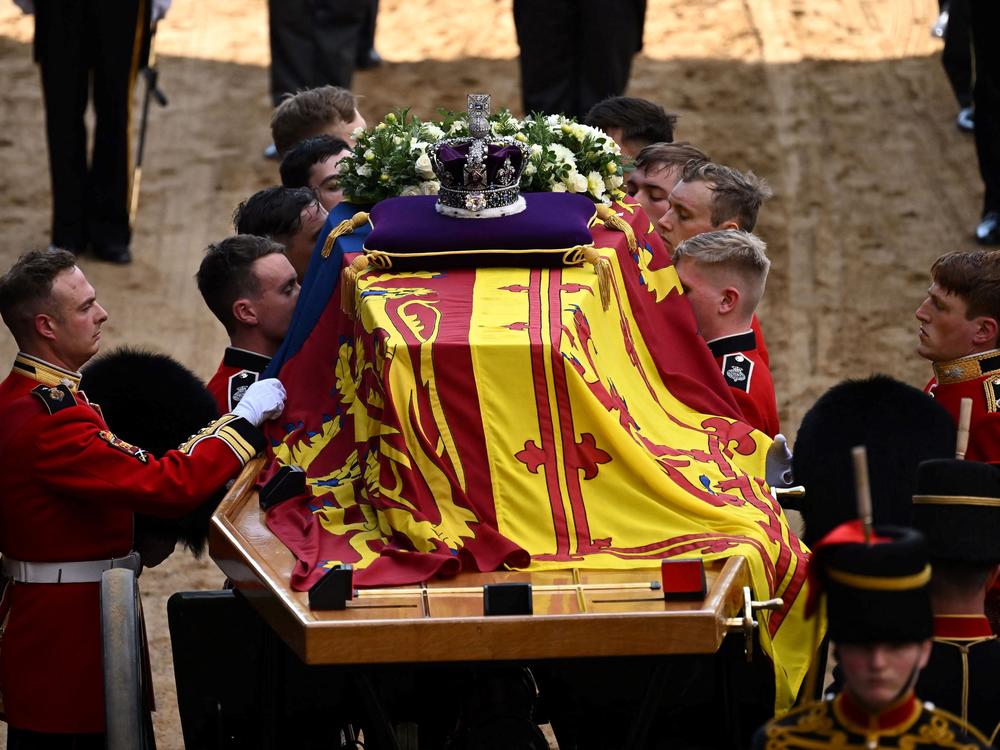Section Branding
Header Content
2,000 guests are due to attend Queen Elizabeth's funeral at Westminster Abbey
Primary Content
LONDON — World leaders including President Biden and the prime ministers of Canada, Ireland, Australia and New Zealand will join members of Britain's royal family at the funeral of the late Queen Elizabeth II Monday morning, held inside Westminster Abbey, where she was both married and later crowned as monarch more than 70 years ago.
The service will also be attended by senior religious figures, British prime ministers past and present, and several other European monarchs, all paying homage to the United Kingdom's longest-reigning queen, who died Sept. 8 at age 96.
The government declared the day a public holiday in Britain, at the urging of Elizabeth's son, King Charles III. It will begin with her coffin traveling the several hundred yards from Westminster Hall, where it has been lying in state inside the oldest building in Britain's parliamentary complex.
The coffin will be carried by a horse-drawn gun carriage of Britain's Royal Navy, alongside dozens of uniformed sailors. Members of Elizabeth's family, including Charles and his eldest son, the new Prince of Wales, William, will likely follow the coffin in a procession.
Some 2,000 guests will file into the Abbey, where the service will be led by Dean of Westminster David Hoyle, with readings from Britain's new prime minister, Liz Truss, and a sermon preached by the U.K.'s most senior cleric, the Archbishop of Canterbury, Justin Welby.
Among the other invited guests will be individuals honored by the queen during her lifetime, including health workers who drew public praise during the pandemic.
The service will conclude with a version of Britain's moving military trumpet reveille, "The Last Post," a 2-minute silence and then a lament from the queen's personal piper, who played his Scottish bagpipes outside her bedroom each morning. King Charles will place the camp color (a regimental flag) of the Grenadier Guards' Queen's Company, a British Army regiment, on his mother's coffin.
Following the state funeral service, her coffin will once more be drawn behind the gun carriage, as far as Hyde Park Corner, a large crossroads between London's larger central park and the rear gardens of Buckingham Palace, with a triumphant arch commemorating the Duke of Wellington's 1815 victory over Napoleon Bonaparte in its center.
From there, the coffin will be transported by hearse to Windsor Castle — Elizabeth's occasional childhood home during World War II and her final permanent home during the pandemic.
A smaller service of some 800 guests will follow inside the castle's chapel, at which point the physical symbols of her rule — the imperial crown, the orb and scepter — will be taken from atop her coffin. Later in the evening her family will hold a private service to lay her to rest, with her body to be interred alongside that of her husband, Prince Philip, the late Duke of Edinburgh, who died last year at the age of 99.
Elizabeth died almost the other side of her kingdom at another of her residences, Balmoral, in northeastern Scotland. In the days since then a national outpouring of grief has been punctuated by a series of ceremonies and traditional commemorations; her coffin was taken to the Scottish capital, Edinburgh, where it lay in state inside the city's cathedral for local residents to pay their respects.
It was subsequently flown south to London, where for several days it has been guarded by members of the British military and others, while tens of thousands of mourners waited for hours before filing into the more than 900-year-old Westminster Hall where the coffin was left.
The British aristocrat responsible by birthright — like his ancestors before him — for organizing the former monarch's funeral is the Duke of Norfolk, Edward William Fitzalan-Howard. He said the people of the U.K. should be proud of the way in which they were paying tribute to Elizabeth over the course of this period, having "come together in recognition of her remarkable legacy."
Copyright 2022 NPR. To see more, visit https://www.npr.org.

